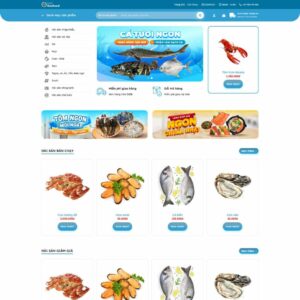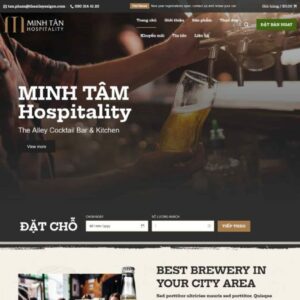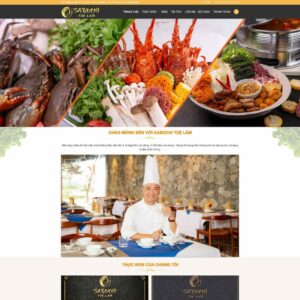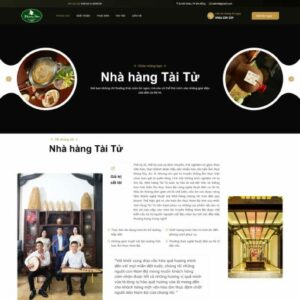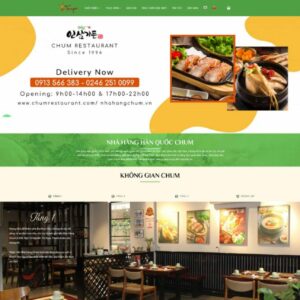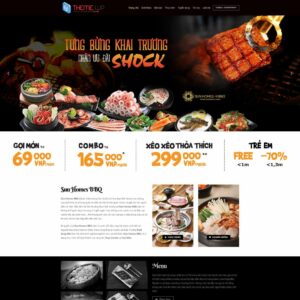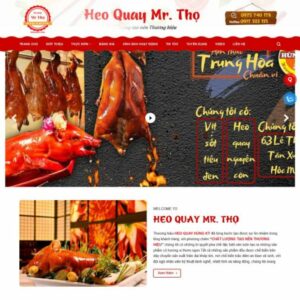
Create a website specializing in cosmetics, makeup, skincare, hair, and nails with WordPress theme 15, easy to manage and optimized for SEO.
The WordPress theme for wedding restaurant at Themewpgiare.com offers a beautiful, professional interface, ideal for restaurants and wedding venues.
WordPress theme specifically for selling seafood, suitable for shops and restaurants, helps increase revenue and effectively attract customers
Seafood Selling WordPress Theme 01 is easy to customize, with a user-friendly interface, making it a great choice for a professional and attractive seafood selling website.
Professional WordPress theme for restaurants selling wine, optimized for SEO with a variety of services, enhancing customer experience and effectively increasing revenue.
The WordPress theme for restaurant 4 features a modern design, SEO optimization, and includes categories like Sales, Restaurant, Hot Theme, and Food, making it perfect for the culinary industry.
Explore beautiful WordPress themes for restaurants that help manage menus easily and attract customers with delicious dishes. Ideal for businesses and restaurants.
Explore beautiful WordPress themes for restaurants with advertising features, unique marketing, and the ability to create attractive landing pages for events and new promotions.
Explore beautiful Wordpress themes for restaurants, perfect for businesses, attracting diners with stunning designs optimized for the food and restaurant industry.
Using the WordPress BBQ restaurant theme helps increase competitiveness, promote the brand, and boost revenue for the restaurant and BBQ joint.
The BBQ Pork WordPress theme helps you showcase your products attractively with high-quality images, detailed descriptions, and essential information for customers.
WordPress theme for culinary bar with a professional interface, easy to customize, allowing you to create a unique website that reflects your culinary style.
1. Benefits of Designing a Professional Restaurant Website
Owning a professional restaurant website helps businesses promote their brand, reach customers, and effectively increase revenue. An SEO-optimized website improves search engine rankings, attracting potential customers. Additionally, the website serves as a platform to provide comprehensive information about the menu, services, and promotions, making it easy for customers to make reservations and plan their dining experiences.
2. Essential Features for a Restaurant Website
A restaurant website needs to integrate all essential features to provide the best experience for customers. The website’s interface should be visually appealing, user-friendly, and optimized for information searches and online reservations.
2.1. Elegant Interface Reflecting the Restaurant’s Style
The restaurant website should be designed to be elegant, modern, and aligned with the restaurant’s style. Colors, images, and layouts should harmonize to reflect the restaurant’s quality and service level. High-quality images of the dining space and dishes will create a positive impression, enticing customers with a sense of hunger and desire to experience the restaurant.
2.2. Intuitive and Detailed Menu
The website should feature a visually intuitive menu that provides detailed information about dishes and drinks, accompanied by attractive images. Each dish should include a description of ingredients, pricing, and nutritional information to facilitate customer choices. The menu should be logically organized by categories such as appetizers, main courses, desserts, and beverages, allowing customers to quickly find their desired items.
2.3. Integration of Online Reservation and Ordering Features
The online reservation and ordering features are essential for a restaurant website. Customers can easily select the date, time, number of guests, and make reservations directly on the website. The online ordering feature allows customers to view the menu, select items, and place orders quickly, enhancing convenience and improving the overall user experience.
3. SEO-Optimized Restaurant Website Design Process
Designing an SEO-friendly restaurant website is crucial for improving customer reach and optimizing business efficiency. A well-structured design process creates a good user experience and helps the website achieve high rankings on search engines.
3.1. Conceptualizing the Interface
The restaurant website’s interface should be elegantly designed, focusing on high-quality, appealing food images to attract customers. The homepage layout should be well-organized, highlighting sections such as restaurant introduction, menu, reservations, and promotions. Call-to-action (CTA) buttons like “Reserve Now” and “View Menu” should be prominently placed to encourage customer interaction.
3.2. Creating Quality Content
The content on the website should focus on providing detailed information about the restaurant, menu, signature dishes, service style, and promotions. Use relevant keywords like “restaurant website design” and “online reservations” naturally within the content to optimize for SEO. Sharing articles about cuisine and dining experiences will help attract and retain customers, while also enhancing the brand’s credibility.
3.3. On-Page SEO Optimization for Restaurant Websites
Optimize SEO elements such as title tags, meta descriptions, headings, URLs, and ALT tags for images on the website. Use internal linking between pages that introduce the restaurant, menu, and reservations to increase connectivity and assist customers in finding information. Optimizing page load speed and ensuring mobile-friendliness are crucial for improving search engine rankings and enhancing user experience.
4. Modern Trends in Restaurant Website Design
Current trends in restaurant website design focus on user experience, integrating modern features, and optimizing the interface.
4.1. Minimalist Design Focused on Dishes
The website’s interface should be designed in a minimalist style, eliminating clutter to allow customers to focus on the dishes and important information. Sharp images of food should be well-arranged on the homepage to capture attention. The website layout should be clear, helping customers easily search for and choose dishes and services.
4.2. Integration of Restaurant Introduction Videos
Incorporating videos showcasing the restaurant’s ambiance, dishes, and service style makes the website more dynamic and visually engaging. Videos not only allow customers to experience the restaurant directly but also create a lasting impression and encourage reservations and orders.
4.3. Mobile Optimization
The restaurant website must be compatible with all devices such as computers, phones, and tablets, allowing customers to access and make reservations and orders anytime, anywhere. This enhances user experience and increases customer reach, especially for those who frequently use their phones to search and book tables.
5. Choosing a Reputable Restaurant Website Design Agency
To own a professional restaurant website, businesses need to select a reputable agency with experience in designing culinary websites. This agency should offer comprehensive design, programming, and SEO optimization services to ensure the website operates effectively, attracts customers, and enhances the online reservation and ordering experience.
Conclusion
Designing an SEO-friendly restaurant website is the optimal solution for businesses to reach customers, promote their brand, and improve business effectiveness. Invest in website design today to build a professional image and achieve sustainable growth in the culinary industry.
Related Keywords:
- Restaurant website design
- Online reservation website
- Culinary website design
- Online food ordering



